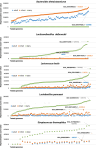Optimal Representative Strain selector-a comprehensive pipeline for selecting next-generation reference strains of bacterial species
- PMID: 39703421
- PMCID: PMC11655286
- DOI: 10.1093/nargab/lqae173
Optimal Representative Strain selector-a comprehensive pipeline for selecting next-generation reference strains of bacterial species
Abstract
Although it is common practice to use historically established 'reference strains' or 'type strains' for laboratory experiments, this approach often overlooks how effectively these strains represent the full ecological, genetic and functional diversity of the species within a specific ecological niche. In this context, this study proposes the Optimal Representative Strain (ORS) selector tool (https://zenodo.org/doi/10.5281/zenodo.13772191), an innovative bioinformatic pipeline capable of evaluating how a strain represents its whole species from a genetic and functional perspective, in addition to considering its ecological distribution in a particular ecological niche. Based on publicly available genomes, the strain that best fits all these three microbiological aspects is designated as an optimal representative strain. Moreover, a user-friendly software called Local Alternative Optimal Representative Strain selector was developed to allow researchers to screen their local library of bacterial strains for an optimal available alternative based on the reference optimal representative strain. Five different bacterial species, i.e. Lacticaseibacillus paracasei, Lactobacillus delbrueckii, Streptococcus thermophilus, Bacteroides thetaiotaomicron and Lactococcus lactis, were tested in three different environments to evaluate the performance of the bioinformatic pipeline in selecting optimal representative strains.
© The Author(s) 2024. Published by Oxford University Press on behalf of NAR Genomics and Bioinformatics.
Conflict of interest statement
None declared.
Figures





References
-
- Tarracchini C., Argentini C., Alessandri G., Lugli G.A., Mancabelli L., Fontana F., Anzalone R., Viappiani A., Turroni F., Ventura M.et al. .. The core genome evolution of Lactobacillus crispatus as a driving force for niche competition in the human vaginal tract. Microb. Biotechnol. 2023; 16:1774–1789. - PMC - PubMed
-
- Aqeel M., Ran J., Hu W., Irshad M.K., Dong L., Akram M.A., Eldesoky G.E., Aljuwayid A.M., Chuah L.F., Deng J.. Plant–soil–microbe interactions in maintaining ecosystem stability and coordinated turnover under changing environmental conditions. Chemosphere. 2023; 318:137924. - PubMed
LinkOut - more resources
Full Text Sources

